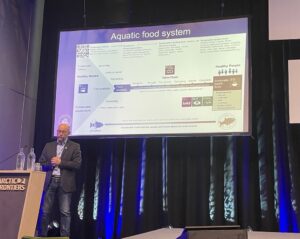Arctic Frontier 2022

Arctic Frontier 2022, hosted from 8th to 11th of May at Tromsø, Norway, discussed multiple ongoing regional and global challenges, projects and innovations surrounding the Arctic region and better utilisation of Arctic resources.
During the session ‘Food from the Ocean and Ocean Science for Sustainable Development – Bridging the UN Decades’, speakers included Dr. Shakuntala Haraksingh Thilsted. Dr. Thilsted highlighted the potential role of aquatic food in helping resolve hunger and malnutrition, and with food system transformation to meet the Sustainable Development Goal ‘Zero Hunger’ by 2030. Novel and low trophic marine resources in the Arctic region were featured including seaweed, blue mussel, and mesopelagic species. Speakers also exemplified methods to reduce waste and loss from aquatic food production in the setting of Arctic region, and suggested to adopt sustainable fishery management and dynamic closure of fishing grounds to strengthen the resilience towards multiple stressors including climate change.

Great challenges in sustainable production of Arctic aquatic food are still in front of us. Dr. Livar Frøyland (Program Director at the Institute of Marine Research Norway) highlighted the effects of climate change and ‘Arctic Atlantification’ of marine resources, and strongly suggested better communication among all relevant parties to break down silos for a balanced sustainability perspective. The impact of climate change on aquatic food production in the Arctic was also emphasized by several speakers including Professor Ray Hilborn, Norwegian Minister of Fisheries and Ocean Policy, Mr. Bjørnar Skjæran, and EU Commissioner of Environment, Oceans and Fisheries, Mr. Virginijus Sinkevičius. Interestingly, some discussion on the impact of climate change on aquatic food production for Arctic indigenous people may seem rather positive in the short term as a result of better fishery landing stocks. However, the long-term effects are yet to be understood (e.g. resulting from ocean acidification and sea-level rising, nutrient availability and temperature increase). Other challenges included consumer acceptance, stakeholder conflicts, market accessibility, funding, seafood frauds, high concentration of iodine and some hazardous elements in seaweeds, and underdeveloped harvesting methods.
[dss-hidden]
